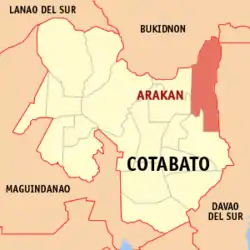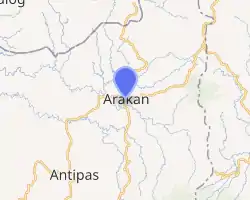Arakan, Cotabato
Arakan, officially the Municipality of Arakan (Hiligaynon: Banwa sang Arakan; Cebuano: Lungsod sa Arakan; Filipino: Bayan ng Arakan) is a 1st class municipality in the province of Cotabato, Philippines. According to the 2015 census, it has a population of 48,228 people. [3]
Arakan | |
|---|---|
| Municipality of Arakan | |
 Seal | |
 Map of Cotabato with Arakan highlighted | |
OpenStreetMap 
| |
.svg.png.webp) Arakan Location within the Philippines | |
| Coordinates: 7°20′55″N 125°07′29″E | |
| Country | |
| Region | Soccsksargen (Region XII) |
| Province | Cotabato |
| District | 2nd District |
| Founded | August 30, 1991 |
| Barangays | 28 (see Barangays) |
| Government | |
| • Type | Sangguniang Bayan |
| • Mayor | Rene V. Rubino Sr. |
| • Vice Mayor | Jenefier A. Anarna-Pangilinan |
| • Representative | Rudy S. Caoagdan |
| • Electorate | 29,273 voters (2019) |
| Area | |
| • Total | 693.22 km2 (267.65 sq mi) |
| Elevation | 244 m (801 ft) |
| Population | |
| • Total | 48,228 |
| • Density | 70/km2 (180/sq mi) |
| • Households | 10,656 |
| Economy | |
| • Income class | 1st municipal income class |
| • Poverty incidence | 44.28% (2015)[4] |
| • Revenue | ₱171,791,019.93 (2016) |
| Time zone | UTC+8 (PST) |
| ZIP code | 9417 |
| PSGC | |
| IDD : area code | +63 (0)64 |
| Climate type | tropical rainforest climate |
| Native languages | Hiligaynon Cebuano Matigsalug Ilianen Tagalog |
| Website | www |
History
The word Arakan is derived from the Manobo term “ara” which means abundance of natural resources in the valley and “kan” which means heroism, bravery and valor of the early Manobo leaders and settlers of the area. The word “arakan” then was named referring to one of the rivers of the valley.[5] Arakan is basically a territory of a number of ethno-linguistic groups, predominantly of the Manobo-Kulamanon and Manobo-Tinananon tribes. The names of the two (2) big rivers in Arakan were also from these ethnic groups of the Kulaman and Tinanan Rivers. The original settlers of the place are the Manobos, which were believed to have originally come from the string of islands in the Malayan Peninsula and Borneo. This assumption is based on their language structure which has Malayan roots.
Throughout the years, they maintained contacts and inter-marriages with other tribes such as Matigsalogs and other lesser Bagobo tribes. The early migrant settlers from Visayas came in as early as the 1930s. Massive clearing of the forest areas became the order of these years for agricultural and settlement purposes. Due to these activities, the Manobos were forced to settle in the inner portions away from those areas occupied by the Bisayans. They were pushed further still and they permanently inhabited the highlands of the valley to avoid social and cultural interactions with the migrant Bisayans.
Early attempts to fully develop Arakan dated back in the 70’s when then Mayor Froilan Matas of the Municipality of Magpet (mother municipality of Arakan) unified his efforts with the Sangguniang Bayan, which was ably supported by the barangay leaders, and its populace led by Greenfield (now Poblacion) Barangay Chairman Aproniano A. Ebon, Sr. through a resolution strongly manifesting its support to the creation of a separate municipality of Arakan. In 1972, a more unified attempts to create the municipality by the provincial leadership has led the passing of House Bill No. 4805 sponsored by the then Assemblyman Salipada K. Pendatun. The declaration of martial law in the same year deterred its creation. This did not however, dampen the hope of the great leaders of Magpet.
The EDSA Revolution that took place in 1986 paved way to another attempt of the creation of a separate and new municipality through the collaborative efforts of the municipal government of Magpet spearheaded by then Vice Mayor Aproniano A. Ebon, Sr., the provincial leadership headed by then Governor Rosario P. Diaz, M.D. and the most especially by the passage of a house bill sponsored by Congressman Gregorio A. Andolana of the Second District of Cotabato Province.
After five years, the Municipality of Arakan was finally created by virtue of Republic Act No. 7152, approved by President Corazon C. Aquino on August 30, 1991.[6] Under the provision of the Act, it had to elect its new officials in local election on May 11, 1992. The then Vice Mayor Ebon overwhelmingly got the mandate as the first Municipal Mayor, while David B. Figura, Sr. was the first Vice Mayor. Ebon spent three terms as municipal mayor, as did David B. Figura, Sr. (who died before his last term ended).
Barangays
Arakan is politically subdivided into 28 barangays. [2]
- Allab
- Anapolon
- Badiangon
- Binoongan
- Dallag
- Datu Ladayon
- Datu Matangkil
- Doroluman
- Gambodes
- Ganatan
- Kabalantian
- Katipunan
- Kinawayan
- Kulaman Valley
- Lanao Kuran
- Libertad
- Makalangot
- Malibatuan
- Maria Caridad
- Meocan
- Naje
- Napalico
- Poblacion
- Salasang
- San Miguel
- Santo Niño
- Sumalili
- Tumanding
Demographics
| Year | Pop. | ±% p.a. |
|---|---|---|
| 1995 | 27,554 | — |
| 2000 | 34,588 | +4.99% |
| 2007 | 38,717 | +1.57% |
| 2010 | 43,554 | +4.38% |
| 2015 | 48,228 | +1.96% |
| Source: Philippine Statistics Authority [3] [7] [8][9] | ||
In the 2015 census, the population of Arakan, Cotabato, was 48,228 people, [3] with a density of 70 inhabitants per square kilometre or 180 inhabitants per square mile.
Climate
| Climate data for Arakan, Cotabato | |||||||||||||
|---|---|---|---|---|---|---|---|---|---|---|---|---|---|
| Month | Jan | Feb | Mar | Apr | May | Jun | Jul | Aug | Sep | Oct | Nov | Dec | Year |
| Average high °C (°F) | 29 (84) |
29 (84) |
30 (86) |
31 (88) |
30 (86) |
29 (84) |
29 (84) |
29 (84) |
29 (84) |
29 (84) |
29 (84) |
29 (84) |
29 (85) |
| Average low °C (°F) | 20 (68) |
20 (68) |
20 (68) |
21 (70) |
22 (72) |
22 (72) |
22 (72) |
22 (72) |
22 (72) |
22 (72) |
22 (72) |
21 (70) |
21 (71) |
| Average precipitation mm (inches) | 46 (1.8) |
35 (1.4) |
41 (1.6) |
38 (1.5) |
67 (2.6) |
79 (3.1) |
68 (2.7) |
66 (2.6) |
52 (2.0) |
59 (2.3) |
62 (2.4) |
45 (1.8) |
658 (25.8) |
| Average rainy days | 11.4 | 9.7 | 12.3 | 14.1 | 22.1 | 23.7 | 22.7 | 21.8 | 19.2 | 21.8 | 20.2 | 14.8 | 213.8 |
| Source: Meteoblue [10] | |||||||||||||
Tourist attractions
- Epol River, (in Barangay Gambodes) has 6 series of waterfalls and river pools and is 3 kilometres (1.9 mi) long.
- Matigol Falls, (in Inamong, Barangay Datu Ladayon), has a cave beside it and is 100 metres (330 ft) high.
- Lake Luningning, (in Barangay Ganatan) has a depth of 30 metres (98 ft) and an underground spring. It is 4 hectares (9.9 acres) wide.
- Tinanan River, (in Valencia, Santo Niño) has 6 springs and two unexplored caves.
- Gaem Cave, a church-like cave (in Sitio Langub, Barangay Gambodes), has an area of 900 square metres (9,700 sq ft) and a height of 10 metres (33 ft).
- Bukatol Cave and Park, (in Bukatol, Barangay Kinawayan). From Mt. Sinaka, the Arakan Valley can be viewed.
- Forest Wildlife Park, 500 hectares (1,200 acres) of forest (in Sinai, Barangay Salasang), home to Philippine Eagles and hornbills
- Bokwan Falls, 5-tiered and 15 metres (49 ft) (in Upper Lombo, Barangay Kabalantian)
- Salasang Cave and Spring (Formon/Natubalan, Barangay Salasang)
- Nabuns Cave (Sitio Langub, Barangay Gambodes)
- Nanilungan Falls, 50 metres (160 ft) high (in Barangay Gambodes)
- Yellow Gate zipline (in sitio Langub, Barangay Gambodes).
- Datu Ladayon Rice Terraces (in Datu Ladayon), the only terraced paddies in the area
- Aguas falls (Sitio Dao, Barangay Salasang)
Local government
As of 2012, Gerardo Tuble Sr. is municipal mayor.
- Vice Mayor:
- Rene V. Rubino
- Councilors:
- Aproniano A.Ebon Sr.
- Jenefier A. Pangilinan
- Luis Bunsuran
- Richard A. Gayatin
- Leonardo S. Reovoca
- Sumerado Ambato
- Josie V. Nasiluan
- Winnie P. Canario
References
- Municipality of Arakan | (DILG)
- "Province: North Cotabato". PSGC Interactive. Quezon City, Philippines: Philippine Statistics Authority. Retrieved 12 November 2016.
- Census of Population (2015). "Region XII (Soccsksargen)". Total Population by Province, City, Municipality and Barangay. PSA. Retrieved 20 June 2016.
- "PSA releases the 2015 Municipal and City Level Poverty Estimates". Quezon City, Philippines. Retrieved 12 October 2019.
- http://www.arakan-cotabatoprov.gov.ph/index.php?cat1=2&cat2=1%5B%5D
- "Republic Act No. 7152; An Act Creating the Municipality of Arakan in the Province of Cotabato". Chan Robles Virtual Law Library. 30 August 1991. Retrieved 28 January 2016.
- Census of Population and Housing (2010). "Region XII (Soccsksargen)". Total Population by Province, City, Municipality and Barangay. NSO. Retrieved 29 June 2016.
- Censuses of Population (1903–2007). "Region XII (Soccsksargen)". Table 1. Population Enumerated in Various Censuses by Province/Highly Urbanized City: 1903 to 2007. NSO.
- "Province of North Cotabato". Municipality Population Data. Local Water Utilities Administration Research Division. Retrieved 17 December 2016.
- "Arakan: Average Temperatures and Rainfall". Meteoblue. Retrieved 30 January 2020.